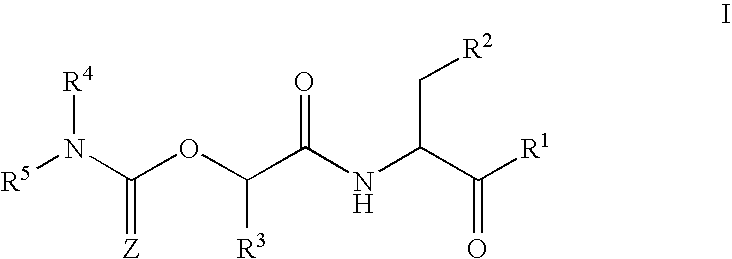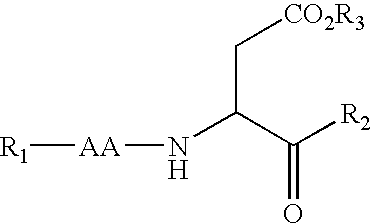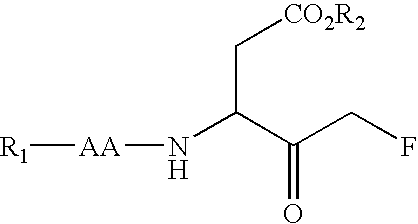Carbamate caspase inhibitors and uses thereof
a technology of carbamate caspase and inhibitors, applied in the field of medicinal chemistry, can solve the problems of undesirable pharmacological properties of peptide inhibitors, poor oral absorption, and inability to reflect potency in cellular models, and achieve good cell penetration and pharmacokinetic properties, good efficacy, and good efficacy.
- Summary
- Abstract
- Description
- Claims
- Application Information
AI Technical Summary
Benefits of technology
Problems solved by technology
Method used
Image
Examples
synthesis examples
[0109]The following Examples provide synthetic procedures for selected compounds of this invention.
example 1
[3S / R]-5-Fluoro-4-oxo-3-[(S)-3-methyl-2-(carbazole-carbamoyloxy-butyrylamino]-pentanoic acid
[0110]
Method A:
(S)-2-(chlorocarbamoyloxy)-3-methylbutyric acid, tert-butyl ester
[0111]
[0112]To a solution of diphosgene (4.55 g) in THF (34 ml) at 0° C. was added a solution of (S)-2-hydroxy-3-methylbutyric acid tert-butyl ester (for preparation method see Tetrahedron. Lett., (1993), 7409) (4.0 g) and pyridine (1.82 g) in THF (34 ml) dropwise over 25 minutes. The resulting mixture was allowed to warm to room temperature over 4 hours. The mixture was then filtered through celite and the filtrate concentrated under reduced pressure. The residue was re-dissolved in diethyl ether (200 ml) and again filtered through celite. The filtrate was concentrated under reduced pressure to give the sub-title compound as a pale yellow oil (5.27 g): 1H NMR (400 MHz, CDCl3) δ 0.98–1.10 (6H, m), 1.55 (9H, s), 2.30 (1H, m), 4.83 (1H, m).
Method B:
(S)-3-methyl-2-(carbazole-carbamoyloxy)-butyric acid, tert-butyl est...
example 1a
[3S / R]-5-Fluoro-4-oxo-3-[(S)-3-methyl-2-(carbazole)-carbamoyloxy-butyrylamino]-pentanoic acid
[0121]
[0122]This was prepared using procedure similar to that described above in Method C. The product was isolated as a white solid (88% last step): IR (solid) 1721.2, 1695.6, 1664.9, 1449.8, 1378.1, 1198.9, 1040.1, 758.5 cm−1; 1H NMR (400 MHz, d6-DMSO) δ 1.10 (6H, brm), 2.41 (1H, m), 2.54–3.04 (2H, m), 4.31–4.82 (1.6H, m, CH2F), 5.10–5.41 (2.4H, m), 7.45 (2H, m), 7.57 (2H, m), 8.22 (2H, m), 8.30 (2H, m), 8.51–8.99 (1H, brm), 12.60 (1H, brs); 13C NMR (100 MHz, d6-DMSO) δ 19.0, 19.1, 19.3, 30.4, 30.5, 30.6, 32.9, 34.5, 34.7, 47.3, 47.4, 52.0, 52.3, 80.4, 80.8, 83.2, 83.4, 83.4, 85.1, 85.2, 116.2, 116.3, 124.1, 125.7, 125.9, 137.9, 151.7, 151.9, 152.0, 168.8, 169.0, 169.2, 172.0, 172.1, 173.1, 173.2, 202.2, 202.4, 202.5, 202.6; 19F NMR (376 MHz, d6-DMSO) −226.6 (t), −226.8 (t), −230.5 (t), −230.9(t), −232.9(t), −233.0 (t); MS (ESI +ve) 443(M+H).
PUM
| Property | Measurement | Unit |
|---|---|---|
| molecular weight | aaaaa | aaaaa |
| temperature | aaaaa | aaaaa |
| concentration | aaaaa | aaaaa |
Abstract
Description
Claims
Application Information
 Login to View More
Login to View More - R&D
- Intellectual Property
- Life Sciences
- Materials
- Tech Scout
- Unparalleled Data Quality
- Higher Quality Content
- 60% Fewer Hallucinations
Browse by: Latest US Patents, China's latest patents, Technical Efficacy Thesaurus, Application Domain, Technology Topic, Popular Technical Reports.
© 2025 PatSnap. All rights reserved.Legal|Privacy policy|Modern Slavery Act Transparency Statement|Sitemap|About US| Contact US: help@patsnap.com



